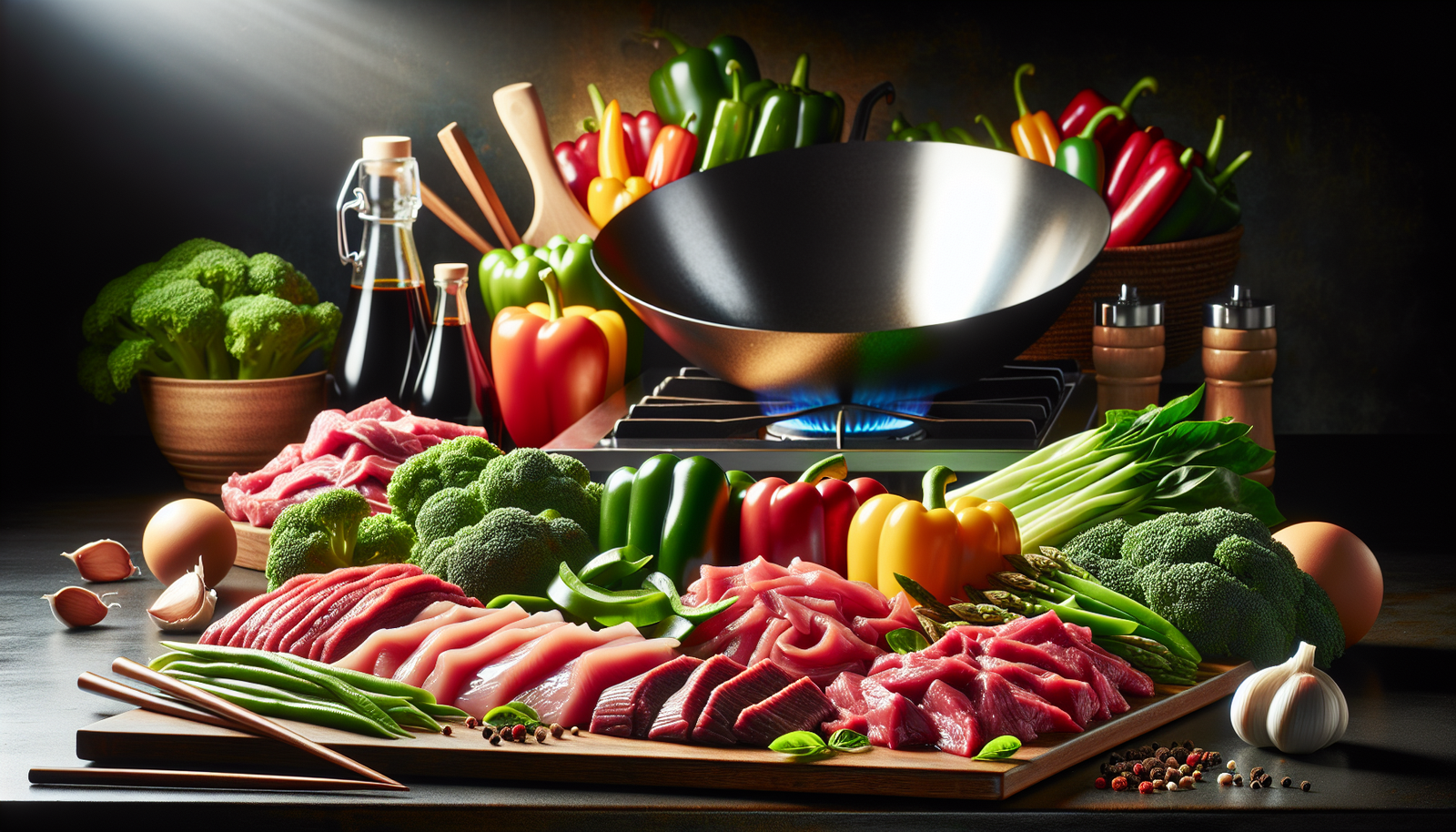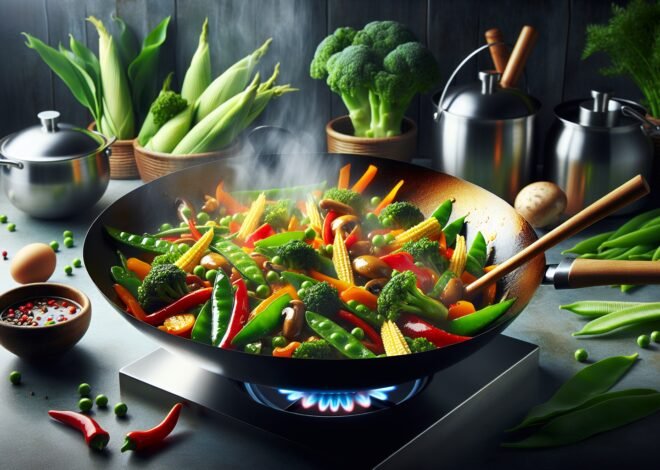
Best Meat Cuts for Stir-Frying: Tips for Tender and Juicy Results
Best meat for stir-frying includes cuts like flank steak, chicken breast, and pork tenderloin, known for their tender texture and rich flavors. About 62% of stir-fry fans regard beef as their go-to protein, highlighting its popularity. This guide will explore the top cuts for stir-frying, providing insight into achieving juicy and tender results with each option. Readers will gain tips on preparation, marinating, and cooking methods to enhance their stir-fry dishes. Dive in to transform your meals with simple techniques and the right meat choice.
Best Types of Meat for Stir-Frying
Stir-frying is all about quick, high-heat cooking, making the choice of meat crucial for the right texture and flavor. Each type of meat brings a unique taste and tenderness to your dish. Whether you’re opting for beef, pork, or chicken, knowing the best cuts enhances your culinary experience.
Choosing the Right Cut for Beef Stir-Fry
Beef is a favorite for stir-fry due to its bold flavor and satisfying texture. The key is selecting cuts that are tender and cook quickly. Popular choices include:
- Flank steak: Known for its rich taste, it’s best sliced against the grain for optimal tenderness.
- Sirloin: A lean cut that balances flavor and price, perfect for those looking for a mid-range option.
- Ribeye: Offers marbling and a juicy texture, suitable for indulgent stir-fry dishes.
Slicing the beef thinly across the grain ensures tenderness. Marinating with soy sauce, garlic, and ginger elevates the flavor, making the beef a standout in any stir-fry.
Selecting Pork for Stir-Fry Dishes
Pork brings a distinct, slightly sweet flavor to stir-fried dishes. The right cut can make all the difference. Consider these options:
- Pork tenderloin: This lean cut is simple to slice and quick to cook, ensuring tenderness.
- Pork shoulder: Although it requires more prep, it offers robust flavor and succulence.
- Pork belly: For those who enjoy a richer taste, this fatty cut provides a melt-in-the-mouth experience.
Marinating pork in a mix of soy sauce, honey, and sesame oil complements its natural sweetness and enhances its juicy texture.
Chicken Cuts Ideal for Stir-Fry Recipes
Chicken is versatile and readily absorbs flavors, making it a popular stir-fry ingredient. The best cuts for stir-frying include:
- Chicken breast: Lean and mild, it’s perfect for those who prefer a lighter option.
- Chicken thighs: These are more forgiving due to their higher fat content, providing a juicier result.
- Boneless chicken wings: Ideal for those seeking flavorful morsels that cook swiftly and evenly.
To ensure a tender stir-fry, slice the chicken thinly and marinate with citrus and herbs. This adds depth and maximizes moisture retention during cooking.
Techniques for Preparing and Marinating Meat for Stir-Frying
The preparation and marination of meat play a vital role in achieving a delectable stir-fry. Proper techniques ensure the meat remains tender and flavorful, enhancing the overall dish. Mastering slicing, marinating, and tenderizing can transform a simple stir-fry into a delightful meal.
How to Slice Meat Thinly for Stir-Fry
Thin slicing is crucial for even cooking and absorption of flavors. The thinner the slice, the faster and more uniformly the meat cooks. To slice meat thinly:
- Chill the meat: Partially freeze the meat for about 15-20 minutes to firm it up. This makes slicing easier.
- Use a sharp knife: A sharp blade ensures clean cuts without tearing the meat fibers.
- Cut against the grain: Look for the direction of the muscle fibers and slice perpendicular to them for maximum tenderness.
Maintaining consistent thickness in each slice guarantees uniform cooking. This technique is the foundation of a successful stir-fry, allowing each piece to brown nicely and remain tender.
Effective Marinating Tips for Juicy Stir-Fry
Marinating is essential for infusing flavor and ensuring juiciness. A good marinade acts as both a flavor enhancer and a tenderizer. Here’s how to make the most of it:
- Balance flavors: Combine salty, sweet, sour, and umami elements such as soy sauce, sugar, vinegar, and garlic.
- Include an acid: Ingredients like lemon juice or vinegar break down proteins, tenderizing the meat.
- Time it right: Marinate for at least 30 minutes, but no more than 24 hours to avoid mushiness.
For an extra touch, add a bit of cornstarch to the marinade. This creates a protective layer that traps moisture, resulting in succulent stir-fry dishes.
Understanding the Role of Meat Tenderizing in Stir-Frying
Tenderizing meat ensures it remains soft and juicy, even under high heat. Several techniques can achieve this:
- Mechanical tenderizing: Use a mallet to gently pound the meat, breaking down tough fibers.
- Acid-based tenderizing: Marinate with citrus or vinegar to weaken protein bonds.
- Enzymatic tenderizing: Use pineapple or papaya extracts, which contain natural enzymes that soften the meat.
Tenderizing is particularly useful for tougher cuts, allowing them to be used effectively in stir-frying. This step ensures every bite is a pleasure, maintaining the integrity and flavor of the dish.
Cooking Methods to Achieve Tender and Juicy Stir-Fry
The cooking technique in stir-frying is as important as the choice and preparation of meat. Achieving a tender and juicy stir-fry requires attention to heat, batch sizes, and cooking sequences. Executing these methods with precision ensures a delightful dining experience.
Utilizing High Heat for Perfect Meat Stir-Fry
High heat is a hallmark of stir-frying, ensuring a quick sear that locks in juices and flavors. To make the most of high heat:
- Preheat the pan: Ensure the wok or skillet is hot before adding oil to prevent sticking.
- Use high smoke point oils: Opt for oils like peanut or vegetable that can withstand high temperatures without burning.
- Quick and continuous motion: Stir constantly to promote even cooking and prevent burning.
A searing high heat creates a caramelized exterior while keeping the inside tender. This technique is vital for achieving the authentic stir-fry texture and flavor.
Importance of Cooking in Small Batches for Stir-Frying
Cooking in small batches is critical for maintaining high heat and achieving even cooking. Overcrowding leads to steaming rather than frying. To avoid this:
- Portion control: Cook no more than a single layer of meat at a time.
- Space out additions: Add ingredients gradually rather than all at once.
- Remove cooked items: Temporarily set aside cooked meat to maintain high heat for vegetables.
This method ensures each piece of meat is perfectly browned and retains its moisture, enhancing the overall quality of the stir-fry.
Timing and Sequence in Stir-Frying Meat and Vegetables
The timing and sequence of adding ingredients can make or break a stir-fry. Coordinating these elements ensures balanced cooking. Consider these tips:
- Start with aromatics: Begin with garlic, ginger, or onions to infuse the oil with flavor.
- Add meat next: Follow with the meat, allowing it to sear and develop flavor.
- Introduce vegetables: Add hearty vegetables first, followed by quicker-cooking ones.
- Finish with sauce: Pour in any sauces towards the end to coat ingredients without diluting them.
Mastering the sequence ensures that all components reach the perfect level of doneness, providing a harmonious blend of flavors and textures in your stir-fry.
Conclusion
Certain cuts of beef, like flank steak and sirloin, are ideal for stir-frying due to their tenderness and flavor. Chicken thighs and breasts are commonly used, with thighs offering juiciness and breasts a leaner option. Pork tenderloin is popular for its tenderness and ability to absorb marinades well. Shrimp is favored for its quick cooking time and sweet taste. Firm tofu can be a great plant-based alternative, holding its shape and absorbing flavors effectively.
FAQ
What cuts of beef are recommended for stir-frying?
Beef stir-fry benefits from cuts like flank steak, sirloin, and ribeye. These cuts deliver tenderness and flavor. Slice them thinly against the grain to enhance texture and ensure quick cooking.
How does chicken compare as a meat choice for stir-frying dishes?
Chicken offers a leaner alternative for stir-fries. It absorbs flavors well and cooks quickly, making it ideal for dishes where time is of the essence. Opt for boneless, skinless chicken breast or thighs for the best results.
What is the best way to prepare pork for stir-frying to enhance flavor?
Pork stir-fry thrives with cuts like tenderloin or shoulder. Marinate the pork in soy sauce, garlic, and ginger to deepen the flavor profile. Cut into thin strips for even cooking and tenderness.
Are there specific techniques to ensure lamb remains tender in stir-fries?
Lamb stir-fry benefits from cuts like leg or loin. Marinating with yogurt or citrus can tenderize the meat. Cook quickly over high heat to retain moisture and tenderness.
Which seafood options are ideal for quick stir-frying recipes?
Seafood options like shrimp, scallops, and thinly sliced fish work well in stir-fries. These cook fast and pair wonderfully with vibrant vegetables and aromatic sauces.
How do I choose the right meat for a vegetarian-friendly stir-fry?
Tofu and tempeh serve as excellent meat alternatives for vegetarian stir-fries. They absorb flavors from sauces and spices effectively. Ensure they are well-pressed and cut into cubes or strips for best texture.











